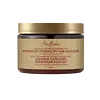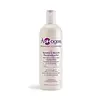What's inside
What's inside
 Key Ingredients
Key Ingredients

 Benefits
Benefits

 Concerns
Concerns

 Ingredients Side-by-side
Ingredients Side-by-side

Water
Skin ConditioningCetearyl Alcohol
EmollientCocos Nucifera Oil
MaskingButyrospermum Parkii Butter
Skin ConditioningGlycerin
HumectantStearyl Alcohol
EmollientBehentrimonium Methosulfate
Cetyl Alcohol
EmollientParfum
MaskingBehentrimonium Chloride
PreservativePanthenol
Skin ConditioningMangifera Indica Seed Butter
Skin ConditioningTrichilia Emetica Seed Butter
EmollientAdansonia Digitata Seed Oil
EmollientHydrolyzed Rice Protein
Skin ConditioningHydrogenated Vegetable Oil
EmollientPersea Gratissima Oil
Skin ConditioningTocopheryl Acetate
AntioxidantHoney
HumectantCetrimonium Chloride
AntimicrobialFicus Carica Fruit/Leaf Extract
Skin ConditioningTocopherol
AntioxidantGlycine Soja Oil
EmollientPropanediol
SolventCaprylyl Glycol
EmollientCaprylhydroxamic Acid
Benzoic Acid
MaskingWater, Cetearyl Alcohol, Cocos Nucifera Oil, Butyrospermum Parkii Butter, Glycerin, Stearyl Alcohol, Behentrimonium Methosulfate, Cetyl Alcohol, Parfum, Behentrimonium Chloride, Panthenol, Mangifera Indica Seed Butter, Trichilia Emetica Seed Butter, Adansonia Digitata Seed Oil, Hydrolyzed Rice Protein, Hydrogenated Vegetable Oil, Persea Gratissima Oil, Tocopheryl Acetate, Honey, Cetrimonium Chloride, Ficus Carica Fruit/Leaf Extract, Tocopherol, Glycine Soja Oil, Propanediol, Caprylyl Glycol, Caprylhydroxamic Acid, Benzoic Acid
Water
Skin ConditioningGlycerin
HumectantCetyl Alcohol
EmollientStearalkonium Chloride
PreservativeParaffinum Liquidum
EmollientSoil Minerals
Skin ConditioningCetearyl Alcohol
EmollientPanthenol
Skin ConditioningTocopheryl Acetate
AntioxidantPersea Gratissima Oil
Skin ConditioningHydrolyzed Vegetable Protein Pg-Propyl Silanetriol
Skin ConditioningMauritia Flexuosa Fruit Oil
Skin ConditioningTriticum Vulgare Germ Oil
EmollientHydrolyzed Keratin
HumectantPhytantriol
HumectantPetrolatum
EmollientPolysorbate 60
EmulsifyingAmodimethicone
Stearyl Alcohol
EmollientPolyquaternium-10
Hydroxyethylcellulose
Emulsion StabilisingTrideceth-12
EmulsifyingCetrimonium Chloride
AntimicrobialCollagen Amino Acids
MoisturisingSqualane
EmollientHydrolyzed Glycosaminoglycans
HumectantLinoleic Acid
CleansingLinoleamidopropyl Pg-Dimonium Chloride Phosphate
Trimethylsiloxyamodimethicone
C11-15 Pareth-7
EmulsifyingC12-16 Pareth-9
EmulsifyingLinolenic Acid
CleansingCitric Acid
BufferingDMDM Hydantoin
PreservativeDisodium EDTA
Parfum
MaskingBenzyl Alcohol
PerfumingBenzyl Benzoate
AntimicrobialWater, Glycerin, Cetyl Alcohol, Stearalkonium Chloride, Paraffinum Liquidum, Soil Minerals, Cetearyl Alcohol, Panthenol, Tocopheryl Acetate, Persea Gratissima Oil, Hydrolyzed Vegetable Protein Pg-Propyl Silanetriol, Mauritia Flexuosa Fruit Oil, Triticum Vulgare Germ Oil, Hydrolyzed Keratin, Phytantriol, Petrolatum, Polysorbate 60, Amodimethicone, Stearyl Alcohol, Polyquaternium-10, Hydroxyethylcellulose, Trideceth-12, Cetrimonium Chloride, Collagen Amino Acids, Squalane, Hydrolyzed Glycosaminoglycans, Linoleic Acid, Linoleamidopropyl Pg-Dimonium Chloride Phosphate, Trimethylsiloxyamodimethicone, C11-15 Pareth-7, C12-16 Pareth-9, Linolenic Acid, Citric Acid, DMDM Hydantoin, Disodium EDTA, Parfum, Benzyl Alcohol, Benzyl Benzoate
 Reviews
Reviews

Ingredients Explained
These ingredients are found in both products.
Ingredients higher up in an ingredient list are typically present in a larger amount.
Cetearyl alcohol is a mixture of two fatty alcohols: cetyl alcohol and stearyl alcohol. It is mainly used as an emulsifier. Emulsifiers help prevent the separation of oils and products. Due to its composition, it can also be used to thicken a product or help create foam.
Cetearyl alcohol is an emollient. Emollients help soothe and hydrate the skin by trapping moisture.
Studies show Cetearyl alcohol is non-toxic and non-irritating. The FDA allows products labeled "alcohol-free" to have fatty alcohols.
This ingredient is usually derived from plant oils such as palm, vegetable, or coconut oils. There is debate on whether this ingredient will cause acne.
Due to the fatty acid base, this ingredient may not be Malassezia folliculitis safe.
Learn more about Cetearyl AlcoholThis ingredient is a preservative, antimicrobial, and emulsifier. It is often used in cosmetics for its ability to cleanse, condition, and reduce static.
Cetrimonium chloride is a quaternary ammonium salt, meaning it has a water-soluble structure.
Cetyl Alcohol is a fatty alcohol. Fatty Alcohols are most often used as an emollient or to thicken a product.
Its main roles are:
Though it has "alcohol" in the name, it is not related to denatured alcohol or ethyl alcohol.
The FDA allows products labeled "alcohol-free" to have fatty alcohols.
Learn more about Cetyl AlcoholGlycerin is already naturally found in your skin. It helps moisturize and protect your skin.
A study from 2016 found glycerin to be more effective as a humectant than AHAs and hyaluronic acid.
As a humectant, it helps the skin stay hydrated by pulling moisture to your skin. The low molecular weight of glycerin allows it to pull moisture into the deeper layers of your skin.
Hydrated skin improves your skin barrier; Your skin barrier helps protect against irritants and bacteria.
Glycerin has also been found to have antimicrobial and antiviral properties. Due to these properties, glycerin is often used in wound and burn treatments.
In cosmetics, glycerin is usually derived from plants such as soybean or palm. However, it can also be sourced from animals, such as tallow or animal fat.
This ingredient is organic, colorless, odorless, and non-toxic.
Glycerin is the name for this ingredient in American English. British English uses Glycerol/Glycerine.
Learn more about GlycerinPanthenol is a common ingredient that helps hydrate and soothe the skin. It is found naturally in our skin and hair.
There are two forms of panthenol: D and L.
D-panthenol is also known as dexpanthenol. Most cosmetics use dexpanthenol or a mixture of D and L-panthenol.
Panthenol is famous due to its ability to go deeper into the skin's layers. Using this ingredient has numerous pros (and no cons):
Like hyaluronic acid, panthenol is a humectant. Humectants are able to bind and hold large amounts of water to keep skin hydrated.
This ingredient works well for wound healing. It works by increasing tissue in the wound and helps close open wounds.
Once oxidized, panthenol converts to pantothenic acid. Panthothenic acid is found in all living cells.
This ingredient is also referred to as pro-vitamin B5.
Learn more about PanthenolParfum is a catch-all term for an ingredient or more that is used to give a scent to products.
Also called "fragrance", this ingredient can be a blend of hundreds of chemicals or plant oils. This means every product with "fragrance" or "parfum" in the ingredients list is a different mixture.
For instance, Habanolide is a proprietary trade name for a specific aroma chemical. When used as a fragrance ingredient in cosmetics, most aroma chemicals fall under the broad labeling category of “FRAGRANCE” or “PARFUM” according to EU and US regulations.
The term 'parfum' or 'fragrance' is not regulated in many countries. In many cases, it is up to the brand to define this term.
For instance, many brands choose to label themselves as "fragrance-free" because they are not using synthetic fragrances. However, their products may still contain ingredients such as essential oils that are considered a fragrance by INCI standards.
One example is Calendula flower extract. Calendula is an essential oil that still imparts a scent or 'fragrance'.
Depending on the blend, the ingredients in the mixture can cause allergies and sensitivities on the skin. Some ingredients that are known EU allergens include linalool and citronellol.
Parfum can also be used to mask or cover an unpleasant scent.
The bottom line is: not all fragrances/parfum/ingredients are created equally. If you are worried about fragrances, we recommend taking a closer look at an ingredient. And of course, we always recommend speaking with a professional.
Learn more about ParfumPersea Gratissima Oil is also known as avocado oil.
Avocado Oil has antioxidant properties. It is mostly made up of the glycerides of fatty acids. About 67% of these fatty acids is made up of oleic acid. Palmitic acid and linoleic acid are also present.
These fatty acids help hydrate and soften the skin. It may increase collagen content in the skin. Collagen helps keep your skin plump and firm. This ingredient helps reduce inflammation and has not shown to clog pores.
This ingredient may not be fungal-acne safe due to its high fatty acid content.
Avocados also have B vitamins, vitamin K, vitamin C, vitamin E, and potassium.
Learn more about Persea Gratissima OilStearyl Alcohol is a type of fatty alcohol from stearic acid. It is a white, waxy compound used to emulsify ingredients.
Fatty Alcohols are most often used as an emollient or to thicken a product. Emollients help soothe and hydrate the skin by trapping moisture.
They are usually derived from natural fats and oils and therefore do not have the same drying or irritating effect as solvent alcohols. FDA allows products labeled "alcohol-free" to have fatty alcohols.
Learn more about Stearyl AlcoholTocopheryl Acetate is AKA Vitamin E. It is an antioxidant and protects your skin from free radicals. Free radicals damage the skin by breaking down collagen.
One study found using Tocopheryl Acetate with Vitamin C decreased the number of sunburned cells.
Tocopheryl Acetate is commonly found in both skincare and dietary supplements.
Learn more about Tocopheryl AcetateWater. It's the most common cosmetic ingredient of all. You'll usually see it at the top of ingredient lists, meaning that it makes up the largest part of the product.
So why is it so popular? Water most often acts as a solvent - this means that it helps dissolve other ingredients into the formulation.
You'll also recognize water as that liquid we all need to stay alive. If you see this, drink a glass of water. Stay hydrated!
Learn more about Water